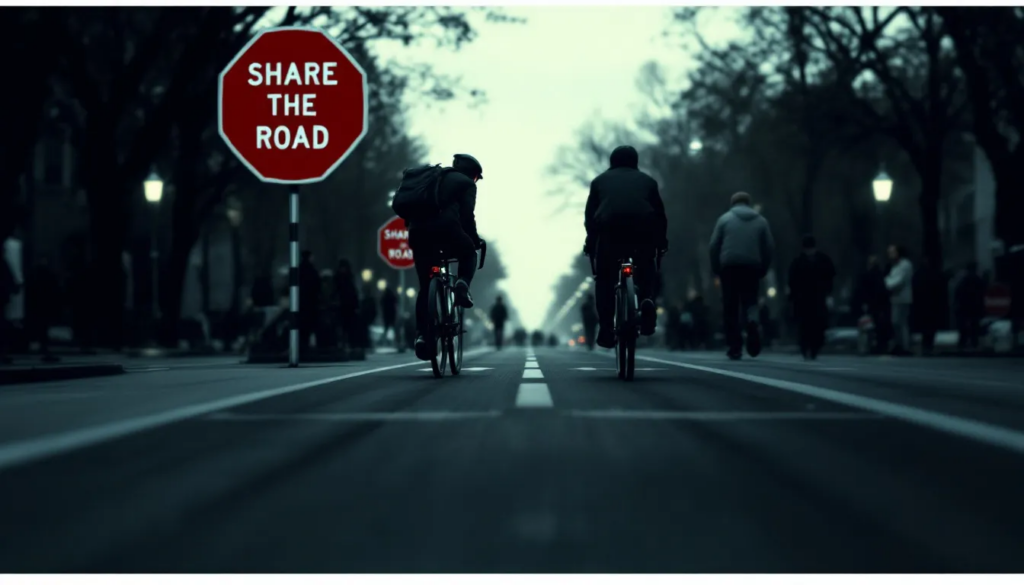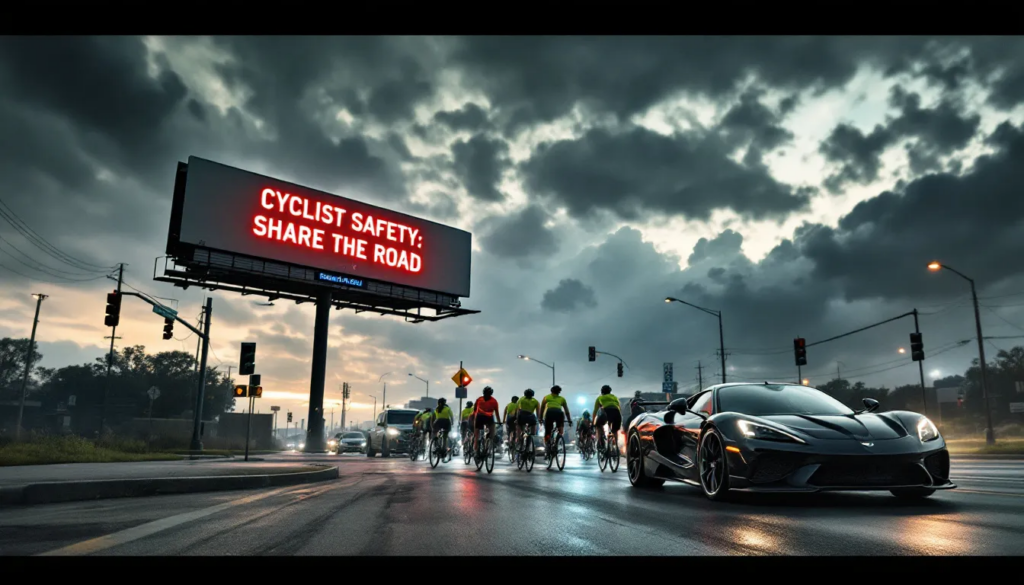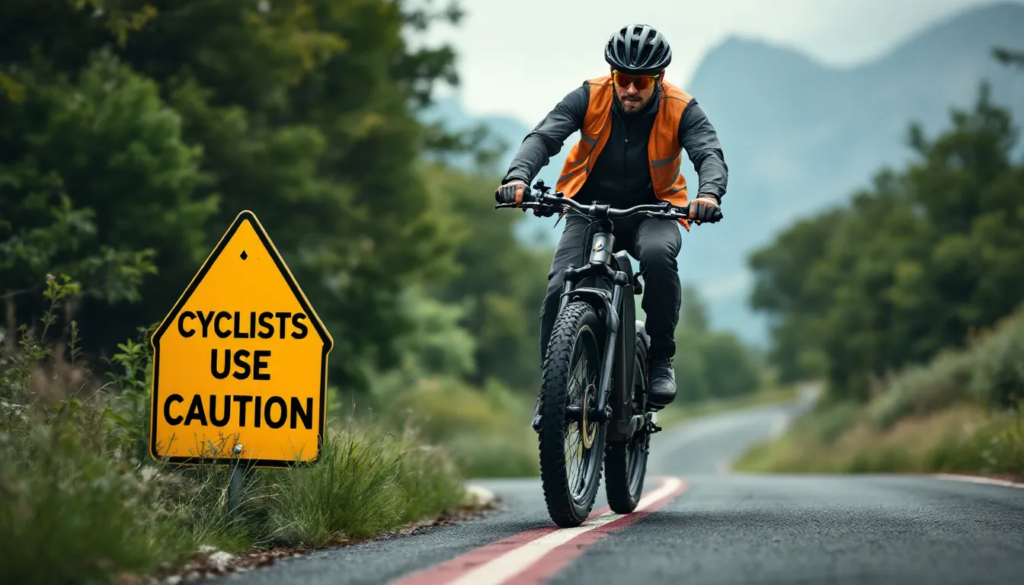Involved in a Texas cycling accident? This article covers the common causes, legal responsibilities, safety requirements, and steps to take after an accident. Stay informed to protect your rights and ensure your safety on the road.
Key Takeaways
Cyclists in Texas share the same legal responsibilities as motorists, including adhering to traffic laws, yielding at signals, and using proper hand signals.
Safety equipment, such as functioning lights and brakes, is mandated by Texas law to enhance visibility and ensure cyclist safety, particularly at night.
Proper road positioning and the use of designated bicycle lanes are critical for reducing cycling accidents, and drivers must maintain a safe distance when passing cyclists.
Common Causes of Cycling Accidents in Texas

Cycling accidents in Texas are a significant concern, affecting both cyclists and motorists alike. The high number of accidents, such as the 2,347 reported in 2022, underscores the urgent need for enhanced safety measures and awareness. Common causes of these accidents include distracted driving, failure to yield the right of way, and not noticing cyclists on the road. These factors often lead to severe injuries or fatalities, making it imperative for all road users to be vigilant and responsible.
The gravity of the situation calls for a concerted effort from all stakeholders—cyclists, motorists, and law enforcement—to reduce these incidents. Understanding the root causes of cycling accidents can help in devising strategies to prevent them.
For instance, better road positioning, adherence to traffic laws, and using designated bicycle lanes can significantly mitigate the risk of accidents. The statistics serve as a stark reminder of the consequences of negligence and the importance of staying informed and cautious on the roads.
Legal Responsibilities of Persons Operating Bicycles
In Texas, cyclists share the same legal responsibilities as motor vehicle drivers. This means that a person operating a bicycle must adhere to traffic laws just like any other vehicle on the road. Law enforcement agencies play a crucial role in ensuring these laws are followed by issuing citations for violations, thus promoting safety among cyclists and motorists alike. Establishing liability in a cycling accident often involves examining whether both parties adhered to these laws and acted responsibly.
Cyclists must be aware of specific duties applicable to them, such as stopping at traffic signals and using proper hand signals to communicate with other road users. These responsibilities are designed to ensure not only their safety but also the safety of others on the road. Adherence to these regulations by cyclists helps create a safer and more harmonious traffic environment.
Traffic Laws for Bicycle Operators
Traffic laws for bicycle operators are stringent to ensure safety and order on the roads. Cyclists are required to stop at both stop signs and red traffic lights, just like any motor vehicle. They must yield at traffic signals and stop signs, adhering to the same rules as motor vehicles.
Additionally, cyclists must ride close to the right edge of the road unless the roadway is too narrow for safe sharing with motor vehicles, in which case they are permitted to take the full lane. Electric bicycles, which are becoming increasingly popular, are allowed on most public roads and must adhere to the same traffic laws as traditional bicycles.
Cyclists should always ride in the same direction as traffic, as wrong-way cycling significantly increases the risk of accidents. These regulations are in place to ensure that cyclists and motorists can coexist safely on the roads.
Hand Signals and Communication
Effective communication is vital for safety on the road, and for cyclists, this means using hand signals to indicate their intentions. To signal a left turn, cyclists should extend their left arm horizontally. For a right turn, they can either extend their right arm horizontally or their left arm upward. To indicate a stop or to reduce speed, cyclists must extend their left arm and hand downward.
These hand signals are essential for informing other road users of a cyclist’s actions, thereby preventing accidents. Proper use of these signals ensures that cyclists can communicate their movements clearly, making the roads safer for everyone.
Following these practices allows cyclists to navigate traffic confidently and minimize collision risks.
Safety Equipment Requirements
Safety equipment is a crucial aspect of bicycle riding, mandated by Texas bicycle laws to ensure the visibility and safety of cyclists. Every bicycle must have a front lamp that displays a white light visible from at least 500 feet ahead, and a rear red reflector or a red light visible from 500 feet when riding at night. These lights are essential for making cyclists visible to other road users, especially in low-light conditions.
In addition to lights, bicycles must also have functioning brakes that are brake capable and can effectively cause the wheels to skid on dry surfaces, including a braked wheel skid. This ensures that cyclists can stop quickly and safely in emergencies.
Wearing reflective materials and using a front headlight and rear reflector when biking at night are also required to enhance visibility and reduce the risk of accidents. Following these safety regulations significantly reduces the chances of cyclists being involved in an accident.
Designated Bicycle Lanes and Road Positioning

Designated bicycle lanes are critical for the safe and efficient movement of cyclists on the roads, especially when there is a designated bicycle lane adjacent to the roadway. Blocking these lanes is prohibited as it endangers cyclists and disrupts the normal flow of traffic. Cyclists may legally ride on any street in Texas, except for limited-access freeways, and must yield to pedestrians at crosswalks.
Proper road positioning is essential for safely riding in traffic. Cyclists should ride as far right as possible, except when the lane is too narrow to share safely with motor vehicles. In such cases, cyclists are allowed to occupy the full lane to ensure their safety. This practice helps in preventing accidents and ensures a smoother interaction between cyclists and motorists on the roads.
Steps to Take After a Cycling Accident

In the unfortunate event of a cycling accident, there are crucial steps that must be taken to ensure safety and proper documentation. First, document the accident scene with photos and videos if possible, capturing all relevant details such as injuries and vehicle positions. This evidence can be vital in any subsequent legal proceedings or insurance claims.
Next, exchange personal and insurance details with either the person involved, including names, addresses, and contact information. If the accident results in injury or vehicle damage exceeding $1,000, law enforcement must be notified immediately, and officers are required to file a written report.
Seeking medical attention immediately for any injuries sustained is also crucial, regardless of how minor they may seem at first. Keeping a detailed record of all accident-related information, including medical records, expenses, and recovery progress, will be essential for any legal or insurance processes that follow.
Understanding Liability in Cycling Accidents

Liability in cycling accidents often hinges on driver negligence. Factors such as distracted driving, including phone use and eating, significantly contribute to accidents. Drivers under the influence of alcohol also frequently cause dangerous situations for cyclists. A lack of experience in sharing the road with cyclists can further exacerbate these risks.
Reckless driving behaviors, such as speeding or improper turns, are significant hazards for cyclists. Many accidents occur simply because driver operating do not notice vehicle moving cyclists on the road. When a motorist is found significantly negligent, such as being charged with DWI, liability is usually clear and falls on the driver.
Understanding these factors can help in establishing liability and ensuring that justice is served in the aftermath of an accident.
How to Safely Travel on Texas Roads
Safety on Texas roads requires vigilance and adherence to best practices. Cyclists should ride as far right as possible but avoid unsafe conditions like gutters or hazards. At intersections, they should position themselves to be visible and claim their space appropriately. This not only ensures their safety but also helps in avoiding accidents.
Drivers, on the other hand, must maintain at least three feet of distance when passing cyclists to ensure safe maneuvering. This practice, along with following marked traffic lanes and adhering to speed limits, contributes to a safer environment for all road users. Mutual understanding and respect for each other’s space and rights enable cyclists and motorists to coexist harmoniously on the roads.
The Role of Local Law Enforcement Agencies
Local law enforcement agencies play a pivotal role in investigating cycling accidents and ensuring compliance with Texas bicycle laws. They are responsible for issuing citations for violations and promoting safety among cyclists and motorists alike. When an accident occurs, immediate contact with emergency services by calling 911 is vital to ensure medical help and a police presence at the scene.
Law enforcement officers must also ensure that proper documentation and reports are filed for accidents involving injuries or significant vehicle damage. This not only aids in legal proceedings but also helps in understanding and addressing the root causes of accidents.
Prompt medical evaluation, even for minor injuries, is crucial to ensure proper treatment and documentation.
Electric Bicycles: Special Considerations

Electric bicycles are becoming an increasingly popular alternative to traditional bikes, offering unique features that require specific regulations. In Texas, electric bicycles are categorized into three classes based on speed and motor assistance: Class 1 (pedal-assist, max speed 20 mph), Class 2 (throttle-assisted, max speed 20 mph), and Class 3 (pedal-assist, max speed 28 mph). The maximum power output for electric bike motors is limited to 750 watts, and assistance must cease at speeds of 28 mph or lower.
These regulations are designed to ensure the safe and responsible use of electric bicycles on public roads. Following these specific rules allows riders to enjoy the benefits of electric bicycles and contribute to overall road safety.
Understanding these considerations is essential for anyone looking to use an electric bicycle for commuting or recreational purposes.
Summary
In conclusion, understanding Texas cycling accident laws and safety measures is crucial for ensuring the safety of both cyclists and motorists. By adhering to traffic laws, using proper hand signals, and equipping bicycles with necessary safety gear, cyclists can significantly reduce the risk of accidents. Designated bicycle lanes and proper road positioning further enhance safety, while steps taken after an accident are vital for proper documentation and recovery.
Liability in cycling accidents often depends on driver negligence, and local law enforcement agencies play a critical role in investigating these incidents and enforcing laws. Special considerations for electric bicycles also ensure their safe use on public roads. By promoting awareness and adherence to these regulations, we can work towards a safer road environment for everyone.
Frequently Asked Questions
What should I do immediately after a cycling accident?
It is essential to document the accident scene by taking photos, exchanging personal and insurance information, and notifying law enforcement if required, followed by seeking medical attention. Prioritizing these steps ensures your safety and protects your interests.
Are cyclists required to follow the same traffic laws as motor vehicles in Texas?
Cyclists in Texas are indeed required to follow the same traffic laws as motor vehicles, which includes obeying traffic signals and yielding to pedestrians. Compliance with these laws ensures safety for all road users.
What safety equipment is mandatory for cyclists in Texas?
Cyclists in Texas must use a front lamp, a rear red reflector or light, and functioning brakes, with reflective materials and lights being mandatory at night. Compliance with these regulations is essential for ensuring safety while cycling.
How are electric bicycles regulated in Texas?
Electric bicycles in Texas are classified into three classes, each with distinct regulations regarding speed and motor assistance. Compliance with these classifications is essential for lawful operation on public roads and designated paths.
What role do local law enforcement agencies play in cycling safety?
Local law enforcement agencies play a crucial role in cycling safety by investigating accidents, enforcing bicycle laws, and promoting awareness through education and citations. Their efforts contribute significantly to creating a safer environment for cyclists.


